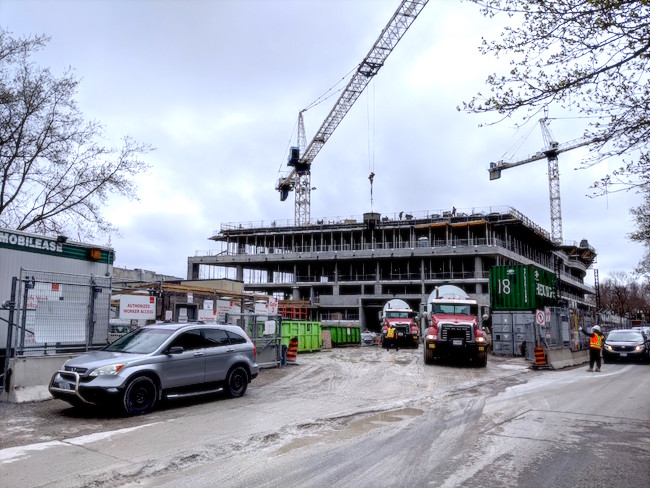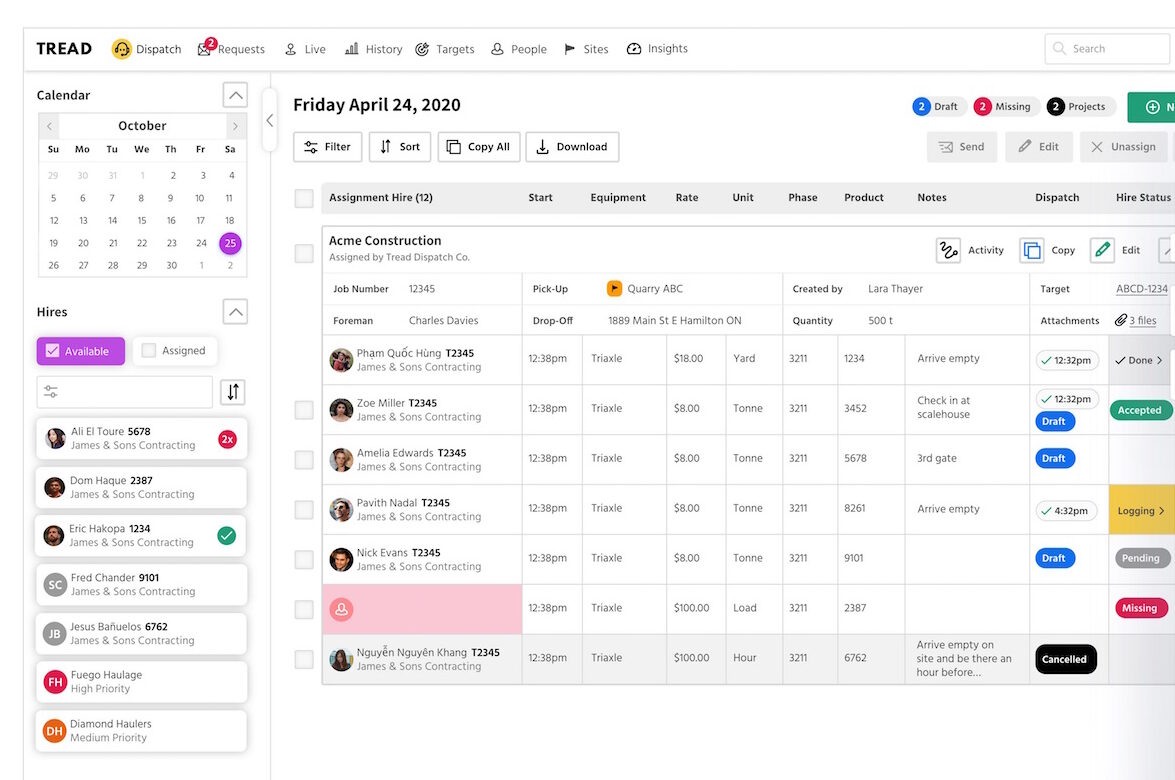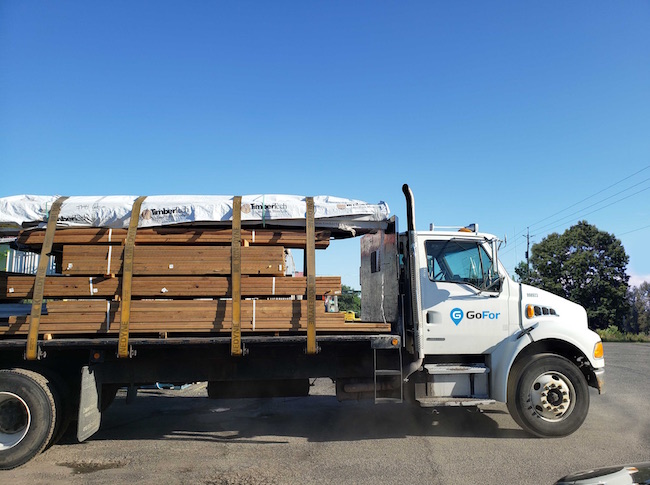
Construction supply chain holds up through pandemic, helped by contractors adopting digital delivery options
By David Kennedy
Construction Materials Trucks COVID-19Contractors and haulers are turning to more advanced contactless options as COVID-19 upends job site delivery protocols

Mixer trucks delivering concrete to a residential development in Toronto. The supply of concrete and other regional materials have held up relatively well throughout the COVID-19 crisis
The construction supply chain has strained under the considerable weight of the COVID-19 pandemic, but in spite of slowdowns at manufacturing plants, revamped procedures at Canadian borders and stricter protocols on job sites, haulers have, generally speaking, continued to deliver the materials needed to keep projects moving forward.
There are exceptions, and many contractors are reporting disruptions or delays, but considering the scale of the crisis, logistics networks have proved relatively resilient, according to Jordan Thomson, a senior manager with KPMG Canada’s Infrastructure Advisory team.
“All in all… the supply chain has held together pretty well,” Thomson said in a recent webinar hosted by the Canadian Construction Association (CCA). “It’s remained intact throughout the pandemic, although we have been hearing from our clients that there are issues, more so on the delays and just difficulties getting things actually to site.”
Thomson noted that key materials such as steel and concrete have remained available, but pointed to issues with more specialized products, such as light fixtures and other manufactured finishes with longer lead times.
Early in the pandemic, a shortage of PPE was another major supply issue. Recent weeks have seen more protective gear become available, but a range of building products remain in short supply.
In Ontario last month, three out of every five contractors in the ICI (industrial, commercial and institutional) sector reported supply chain disruptions at a medium or high level, according to a survey conducted by the Ontario Construction Secretariat (OCS). A similar study conducted several weeks earlier found 63 per cent of contractors were affected by supply chain issues, illustrating marginal improvement between April and May.
Particularly when dealing with international suppliers, Thomson said contractors should be actively engaging with vendors to identify any problems early and get ahead of delays. With the crisis expected to persist for some time, he also advised moving up shipment dates when possible to ensure material and equipment is available when needed.
Beyond these steps, problems with the global supply chain remain largely out of contractors’ hands. But on job sites themselves, builders are adjusting their delivery protocols during the pandemic and turning to new software providers to modernize what have often been pen and paper solutions.
“It feels a little bit like we’ve gone into a bit of time machine and jumped ahead a couple of years in terms of the industry’s propensity to adopt technology,” said Noah Dolgoy, the CEO and co-founder of Tread, in a recent interview.

Tread’s dashboard, highlighting delivery statuses, timelines and other details. Click to englarge. PHOTO: Tread
The Toronto-based tech company has built a digital platform designed to streamline material deliveries and make it easier for contractors and material suppliers to connect with haulers. By digitizing a system that’s relied heavily on phone calls and paper tickets in the past, the platform eliminates much of the human error from the equation.
It also allows haulers to stick to their cabs on job sites, avoiding the exchange of pens or physical invoices — a critical step during the pandemic. The CCA’s site safety guidelines, for instance, advise nothing be passed between deliverers and receivers for the duration of the pandemic and many contractors have built this step into their own action plans.
With the added impetus, over the past two months Dolgoy said a range of barriers — regulatory, administrative and culture — have eroded. “What we’re seeing is not only increased adoption, but increased technical literacy and increased comfort. Comfort with change and desire for change across the board in the industry,” he added.
Ottawa-headquartered GoFor Industries Inc. is another tech company that’s seen its business surge as COVID-19 reconfigures construction’s conventional supply chain.
Unlike Tread, which focuses on the movement of bulk raw materials, GoFor transports a wide range of products for retailers such as HD Supply, The Home Depot and Sherwin Williams. The company moves everything from paint and ABS piping to HVAC equipment and larger palletized materials. The majority of the company’s business revolves around smaller-scale construction like renovations, but about 30 per cent of its deliveries now go out to large projects.

GoFor has seen an uptick in business during the pandemic, but COVID-19 did force it to put significant U.S. expansion plans temporarily on hold. With North America seemingly through the worst of the pandemic, the company is now beginning to restart these efforts. PHOTO: GoFor
“In a lot of ways, we start out kind of filling their gaps — when they need it, or if it’s urgent,” Brad Rollo, the company’s CEO and co-founder, said in a recent interview. “But if you start to look at the way we can do it versus somebody who owns their own vehicle or puts their own staff in it, we’re so much more cost efficient.”
Through GoFor’s app or website, retailers can supplement their own delivery fleet to get materials out to contractors quickly, or contractors themselves can secure a missing component without sending their own staff off-site. Rollo pointed to Pomerleau, Modern Niagara and Ainsworth as a few of the contractors it’s working with.
With many builders having adjusted their site protocols to eliminate any interaction with delivery drivers, GoFor has gone contactless as well.
“Everywhere that you have a point of contact we’ve reduced it to zero,” Rollo said, noting that paperwork has stopped changing hands and its drivers are now wearing masks as a precaution.
Moving forward, as the industry slowly returns to something resembling normal, Rollo anticipates its retailers will shift to a “delivery-first mentality” to compete in the post-COVID world, while contractors will place increased emphasis on the availability of digital storefronts and on-demand deliveries.
With COVID-19 forcing contractors’ hands, the construction industry looks likely to emerge from the pandemic with a firmer grasp of technology and a greater willingness to embrace it. The move to cloud-based construction management software is another example.
In the long run, Dolgoy expects the pandemic will help boost productivity across the sector by turning builders onto the advanced telemetric and artificial intelligence tools that Tread and other companies are offering.
“Those used to feel like dirty words when we talked to clients about them and now they’re so excited… I think it’s very much a harbinger of where the industry’s going.” he said.




